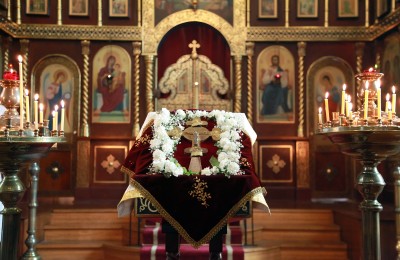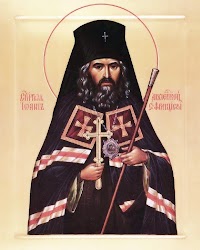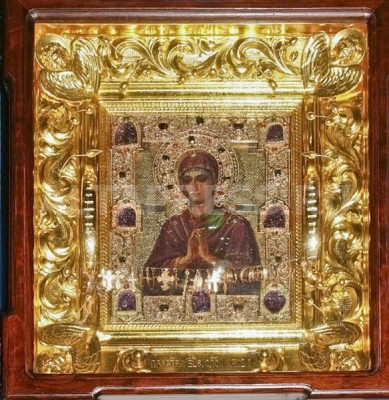 Beginning in the first year of its publication (1965) The Orthodox Word has included several articles on miraculous icons of the Mother of God, such as Joy of All Who Sorrow, Pochaev, Korsun, and Tinos, as an introduction to Orthodox piety relatively unknown and exotic in America. Two of these, the Tikhvin and Kursk “Root” icons, important for their antiquity and role in Russian history, had even appeared on American soil as a result of the upheaval of the Revolution.
Beginning in the first year of its publication (1965) The Orthodox Word has included several articles on miraculous icons of the Mother of God, such as Joy of All Who Sorrow, Pochaev, Korsun, and Tinos, as an introduction to Orthodox piety relatively unknown and exotic in America. Two of these, the Tikhvin and Kursk “Root” icons, important for their antiquity and role in Russian history, had even appeared on American soil as a result of the upheaval of the Revolution.
Myrrh-streaming icons have also appeared in our day, especially in traditionally Orthodox countries, and even manufactured reproductions have not been spurned by the Mother of God as vehicles of her untiring intercession and closeness to God’s people. Such manifestations have the ability to evoke contrition and awe in the presence of the divine, driving away the cares of this world.
In 1999, at the glorification of Matrona “the Blind” of Moscow, Anastasia Basharinaya, the daughter of Margarita Vorobyeva, both of Bachurino, a village on the outskirts of Moscow, placed a lithographic icon of the Mother of God “Softening of Evil Hearts” on the saint’s reliquary. Later this ordinary printed icon, mounted on wood and produced at the Sofrino church goods factory near Moscow, began exuding myrrh in their apartment. In time the miracle began attracting visitors to their home and invitations to various churches. Margarita’s husband, Sergei Fomin, a former member of the armed services, has for several years been the full-time guardian and traveling companion of the icon, which is now in demand throughout Russia and abroad.
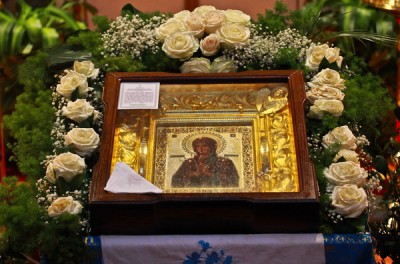 The icon “Softening of Evil Hearts” appeared at an unknown time. It is based on the prophecy of St. Symeon the God-receiver when Mary and Joseph brought the forty-day old Jesus to the Temple, A sword shall pierce through thine own soul (Luke 2:35), which was fulfilled as the Virgin witnessed the calumny against her Son during His earthly ministry, and especially at the time of His sufferings and Crucifixion. The number seven, a significant number in Holy Scripture and patristic literature, denotes the fullness of the Mother of God’s sufferings of soul.
The icon “Softening of Evil Hearts” appeared at an unknown time. It is based on the prophecy of St. Symeon the God-receiver when Mary and Joseph brought the forty-day old Jesus to the Temple, A sword shall pierce through thine own soul (Luke 2:35), which was fulfilled as the Virgin witnessed the calumny against her Son during His earthly ministry, and especially at the time of His sufferings and Crucifixion. The number seven, a significant number in Holy Scripture and patristic literature, denotes the fullness of the Mother of God’s sufferings of soul.
The flow of myrrh from the icon and its fragrance changes according to circumstances. Activity slows during fast periods, especially the first week of Lent and Passion Week. At other times it has foreboded disasters. In 1999, before the terrorist explosions of several apartment buildings in Moscow in which hundreds of people perished, the Theotokos’ face on the icon changed: dark circles appeared under her eyes, and the apartment began to smell of incense. Then on August 12, 2000, the day of the Kursk submarine wreck all the crew members on board perished, tiny bleeding wounds appeared on the icon of the Theotokos. The icon gave off the smell of blood prior to the attack on the Twin Towers in New York City in September 2001.
When Margarita asked her priest what the meaning of the miracle was, he responded, “This is not for your merits and not for your sins. Learn how to live from this.” “And it teaches us to this day,” Sergei surmised. “I was baptized only at twenty-five, and through this wonderworking icon I’m learning to be a believer. I’ve gone with the icon of the Mother of God to many cities. Everywhere they’re happy to see us. We go only where invited…. Each trip for me is like the first time! It’s difficult to get used to a miracle.”
Although the icon has undoubtedly had an impact on its guardian, there have been other miraculous interventions. Fomin witnessed the healing of a woman with a paralyzed right arm at the Trinity church in Ostankino, Moscow. He also reports that various infertile couples have conceived, and those with blood diseases or cancer have improved after praying before the icon. Demon-possessed individuals violently resist approaching the icon.
Parishes and hospitals are common venues for the icon’s travels, but not exclusively. Sergei Polyakov, vice-president of the Veterans Association, “Alpha” Special Forces Division, admitted that for the last ten years, Molebens have been served before the icon prior to many counter-terrorism operations, and the missions were completed successfully. At Chelyabinsk, a Moleben was served at the district administration building, and the mayor himself was baptized during the visit.
“Churches in honor of this icon have been built in two prisons,” said Fomin. “One is in the women’s section for underage girls in the Ryazan region, where the juvenile criminals serve their sentences for especially serious crimes, including murder. Our benefactors undertook to build a church there. The girls also helped a lot; they even dug the trench for the foundation under the church building and wrote a song about the icon, ‘The Softener of Evil Hearts.’ In Yaroslavl, a chapel in honor of this icon has been built in the men’s section. In Altai, in the city of Barnaul, they built a chapel in an orphanage.”
At a visit to the Tolga women’s monastery in 2005, the following miracles were recorded: “My daughter,” related R., a local parishioner, “had been visiting a sect known as the ‘New Generation.’ She became angry whenever I told her about the Tolga Monastery and its wonderworking icon. Nonetheless I talked her into visiting the Tolga women’s monastery. On her first visit she was indifferent and paid no particular attention to the icons or relics. By the mercy of the Queen of Heaven I managed to get her to come back when the icon ‘Softening of Evil Hearts’ came. The myrrh-flowing miraculous image shook up my daughter. She slowly came to herself and suddenly said, ‘You know, Mama, I’m not baptized.’ After this she was baptized and started attending the Orthodox Church. I’m so thankful to the Mother of God for this great miracle, that she returned love and understanding to my daughter.” This grateful woman then donated her gold engagement ring for the adornment of the icon.
Abbess N. was skeptical at first about the myrrh coming from the icon. When she was anointed, due to her unbelief it left a painful red mark on her forehead that looked like a burn. Repenting, she confessed her sin of unbelief to a priest, after which she was anointed a second time. Not only did the red mark disappear, but her soul was filled with peace and consolation. Sergei added, “I remember how in Yalta a paralyzed youth was brought to this icon, and in the evening he could already walk by himself…. A similar incident occurred in Barnaul. On the feast of the Dormition of the Mother of God they brought a four-year-old girl, who had been paralyzed from her birth, to this icon. After she was helped to venerate the icon, the next day she began trying to walk, for the first time in her life.”
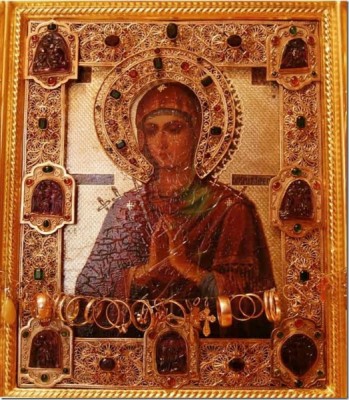 In August 2008, Liza, the one-and-a-half-year-old daughter of Anna Ivanovna Kudratseva, caught herpes of the mouth, which progressed after a misdiagnosis. Finally, after medicines failed to improve her condition, she placed a bead of the myrrh from the icon in Liza’s mouth. “For the first time since becoming sick, my daughter fell asleep peacefully. In the morning, when Liza awoke, I could not believe my eyes. There were no more putrid growths, only bloody sores which quickly began to heal. My daughter’s temperature over the course of the day went down. Liza started to eat and drink a little…. This happened on the eve of the feast of the Transfiguration of the Lord. Thus, since Liza was getting better we hurried to the church and communed the child with the Holy Mysteries. Our daughter was still weak, but her temperature had become normal, and the main thing was that Liza could calmly eat and drink without discomfort.”
In August 2008, Liza, the one-and-a-half-year-old daughter of Anna Ivanovna Kudratseva, caught herpes of the mouth, which progressed after a misdiagnosis. Finally, after medicines failed to improve her condition, she placed a bead of the myrrh from the icon in Liza’s mouth. “For the first time since becoming sick, my daughter fell asleep peacefully. In the morning, when Liza awoke, I could not believe my eyes. There were no more putrid growths, only bloody sores which quickly began to heal. My daughter’s temperature over the course of the day went down. Liza started to eat and drink a little…. This happened on the eve of the feast of the Transfiguration of the Lord. Thus, since Liza was getting better we hurried to the church and communed the child with the Holy Mysteries. Our daughter was still weak, but her temperature had become normal, and the main thing was that Liza could calmly eat and drink without discomfort.”
In January 2009, Patriarch Kyrill of Moscow and All Russia (at that time Metropolitan of Smolensk and locum tenens of the patriarchal throne) invited Sergei and the icon to the Local Council of the Russian Orthodox Church later that month for the election of the new patriarch. When Kyrill was chosen, the icon began producing myrrh abundantly, a fact reported on national television, for which it gained even greater fame. Kyrill later had the icon accompany him for his first pastoral visit to the Ukraine where, since the fall of the Soviet Union, relations between Russia and the Ukraine, as well as between believers in the two countries have been sensitive.
While at the Local Council, Archimandrite Luke of Holy Trinity Monastery in Jordanville, New York, invited the icon and its guardian to the United States, where they visited many cities and churches last fall (2009). Sergei Fomin relates his experiences:
“At the airport [in New York] we were anxious. How would they greet us? How would the trip go? For an interpreter, we had a Russian woman, Tatiana, who worked with American customs. At the check point one of the workers asked us what we were carrying. After looking at the icon, without saying anything, he turned around and ran off somewhere. He returned with five or six of his colleagues. They started to ask us about everything. I saw that the oldest of the group was wearing an Orthodox cross around his neck. ‘Do you have any sort of memento I can give my ailing wife Rose-Marie?’ he asked. We had some small icon cards which we gave to him and the others.
“When we were getting ready to continue our journey, an American woman approached us, also from customs. She put her hand on the suitcase containing the icon, crossed herself in the Roman Catholic way, and started to pray about something for herself. We asked her, ‘Did we give you a little card?’ ‘No,’ she answered, and at the moment we gave her one she started crying, tears coming out of her eyes—she was so obviously surprised. ‘What happened to her?’ wondered the customs workers, and we understood that our visit would be successful.
“In Washington we stayed at the home of a priest. He has things which belonged to José Muñoz-Cortez,3 including the case of the Montreal Iveron icon. ‘Would you like to try it for your icon?’ offered Matushka Maria Potapova. We looked at it. ‘No, it won’t fit. It’s too small.’ ‘Are you so sure? Try it out…’ And what do you think? It turned out the case was as though tailor-made for our icon.
“The icon “Softening of Evil Hearts” was in this case while in Washington. Matushka Maria gave us boards prepared by Brother Joseph (he was an iconographer); someday with God’s help a holy image will be fashioned on these boards…. And so, two miraculous icons of the Mother of Light—one taken from the world for a time, and another which has appeared, mystically touching it on American soil.
“There was a notable occurrence in Burlingame at the All Saints of Russia parish. On September 28, twelve of the fourteen people who had not accepted the Act of Canonical Communion between the Russian Church Abroad and the Moscow Patriarchate came up to Fr. Stefan Pavlenko. Before this, when the Kursk Root icon had come they had not venerated it, but had only stood by and then quietly departed. But this time they venerated and even came up to Fr. Stefan to be anointed. Fr. Stefan was unspeakably thrilled by this.
“In Boston, the head of the Russian Church Abroad Mission in Jerusalem met us, Archimandrite Ioasaph (in the world Francis Joseph McClellan). He was suffering from cancer, and doctors had given him only two months to live. I have to say that in America the icon issued myrrh very little; it was damp, but unfortunately there was not enough of the ‘heavenly dew’ to collect. But when we came to the home of Archimandrite Ioasaph and he prayed before it, to our amazement the icon came alive. Beads of myrrh formed and even flowed. In such a way did the Mother of God respond to his fervent prayer. Not long ago we learned that Archimandrite Ioasaph had departed to the Lord [†Dec. 5/18 2009]…. I want to say that his radiant visage deeply impressed us.
“[In Chicago] Bishop Peter met the icon at the airport. When we passed the icon into his hands, there was an abundant flow of myrrh. One of the local priests, who had been a colonel in the American army before ordination, told us that all his life he had been preparing to go to war with Russia, and now he was praying for her. Such a transformation!”
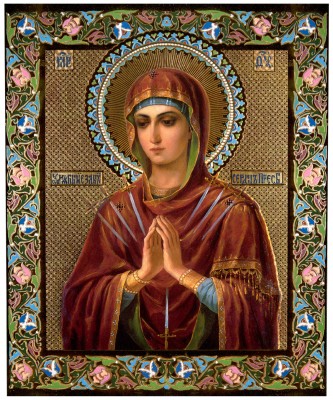 The icon has also been to Australia, Georgia, Germany, Slovakia, Mount Athos, and Cyprus, where there is a new church dedicated to this very icon. In the summer of 2010 it made a return visit to the United States. During this trip, on the eve of the feast of the Prophet Elijah (July 20/August 2), this holy icon arrived at the St. Herman of Alaska Monastery, remaining there for the festal Liturgy, which was served in the woods, in a small skete dedicated to the holy Prophet.
The icon has also been to Australia, Georgia, Germany, Slovakia, Mount Athos, and Cyprus, where there is a new church dedicated to this very icon. In the summer of 2010 it made a return visit to the United States. During this trip, on the eve of the feast of the Prophet Elijah (July 20/August 2), this holy icon arrived at the St. Herman of Alaska Monastery, remaining there for the festal Liturgy, which was served in the woods, in a small skete dedicated to the holy Prophet.
Donations from grateful believers have allowed the construction of a small church in Bachurino, which opened in 2006. Presently, the Divine Liturgy is served there on Sundays and a Moleben is served before the icon on Tuesdays when it is not traveling.



 Russian
Russian